Related Research Articles

An effects unit, effects processor, or effects pedal is an electronic device that alters the sound of a musical instrument or other audio source through audio signal processing.

An audio power amplifier amplifies low-power electronic audio signals, such as the signal from a radio receiver or an electric guitar pickup, to a level that is high enough for driving loudspeakers or headphones. Audio power amplifiers are found in all manner of sound systems including sound reinforcement, public address, home audio systems and musical instrument amplifiers like guitar amplifiers. It is the final electronic stage in a typical audio playback chain before the signal is sent to the loudspeakers.

Vox is a British musical equipment manufacturer founded in 1957 by Thomas Walter Jennings in Dartford, Kent, England. The company is most famous for making the Vox AC30 guitar amplifier, used by The Beatles, The Rolling Stones, The Kinks, The Yardbirds, Queen, Dire Straits, U2, and Radiohead; the Vox Continental electric organ, the Vox wah-wah pedal used by Jimi Hendrix, and a series of innovative electric guitars and bass guitars. Since 1992, Vox has been owned by the Japanese electronics firm Korg.

Audio feedback is a positive feedback situation that may occur when an acoustic path exists between an audio input and an audio output. In this example, a signal received by the microphone is amplified and passed out of the loudspeaker. The sound from the loudspeaker can then be received by the microphone again, amplified further, and then passed out through the loudspeaker again. The frequency of the resulting howl is determined by resonance frequencies in the microphone, amplifier, and loudspeaker, the acoustics of the room, the directional pick-up and emission patterns of the microphone and loudspeaker, and the distance between them. The principles of audio feedback were first discovered by Danish scientist Søren Absalon Larsen, hence it is also known as the Larsen effect.

An instrument amplifier is an electronic device that converts the often barely audible or purely electronic signal of a musical instrument into a larger electronic signal to feed to a loudspeaker. An instrument amplifier is used with musical instruments such as an electric guitar, an electric bass, electric organ, electric piano, synthesizers and drum machine to convert the signal from the pickup or other sound source into an electronic signal that has enough power, due to being routed through a power amplifier, capable of driving one or more loudspeaker that can be heard by the performers and audience.

A guitar amplifier is an electronic device or system that strengthens the electrical signal from a pickup on an electric guitar, bass guitar, or acoustic guitar so that it can produce sound through one or more loudspeakers, which are typically housed in a wooden cabinet. A guitar amplifier may be a standalone wood or metal cabinet that contains only the power amplifier circuits, requiring the use of a separate speaker cabinet–or it may be a "combo" amplifier, which contains both the amplifier and one or more speakers in a wooden cabinet. There is a wide range of sizes and power ratings for guitar amplifiers, from small, lightweight "practice amplifiers" with a single 6-inch speaker and a 10-watt amp to heavy combo amps with four 10-inch or four 12-inch speakers and a 100-watt amplifier, which are loud enough to use in a nightclub or bar performance.
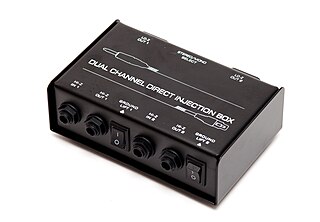
A DI unit is an electronic device typically used in recording studios and in sound reinforcement systems to connect a high output impedance unbalanced output signal to a low-impedance, microphone level, balanced input, usually via an XLR connector and XLR cable. DIs are frequently used to connect an electric guitar or electric bass to a mixing console's microphone input jack. The DI performs level matching, balancing, and either active buffering or passive impedance matching/impedance bridging. DI units are typically metal boxes with input and output jacks and, for more expensive units, “ground lift” and attenuator switches.
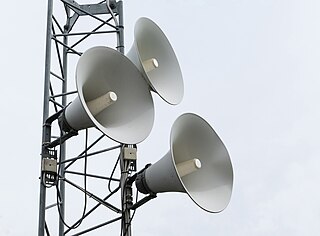
A public address system is an electronic system comprising microphones, amplifiers, loudspeakers, and related equipment. It increases the apparent volume (loudness) of a human voice, musical instrument, or other acoustic sound source or recorded sound or music. PA systems are used in any public venue that requires that an announcer, performer, etc. be sufficiently audible at a distance or over a large area. Typical applications include sports stadiums, public transportation vehicles and facilities, and live or recorded music venues and events. A PA system may include multiple microphones or other sound sources, a mixing console to combine and modify multiple sources, and multiple amplifiers and loudspeakers for louder volume or wider distribution.

A sound reinforcement system is the combination of microphones, signal processors, amplifiers, and loudspeakers in enclosures all controlled by a mixing console that makes live or pre-recorded sounds louder and may also distribute those sounds to a larger or more distant audience. In many situations, a sound reinforcement system is also used to enhance or alter the sound of the sources on the stage, typically by using electronic effects, such as reverb, as opposed to simply amplifying the sources unaltered.

A bass amplifier is a musical instrument electronic device that uses electrical power to make lower-pitched instruments such as the bass guitar or double bass loud enough to be heard by the performers and audience. Bass amps typically consist of a preamplifier, tone controls, a power amplifier and one or more loudspeakers ("drivers") in a cabinet.
Viscount International SpA (Viscount) is a musical instrument manufacturer based in Mondaino, Italy. The brand Viscount was registered in 1969 by Marcello Galanti, but the company was established in the late 19th century by his forefather Antonio Galanti. After 1969 Viscount's primary focus has been on classic organs and digital pianos. Several alternative brands were formed in the 2000s to aim at expanding into other markets: VERSE and Voice Systems, respectively, for the high and low-end Pro-Audio markets and Physis for digital organs using Viscount's physical modeling technology. The company also used the Oberheim brand for several years, to market vintage organs, synthesizers and guitar effects. Currently, Viscount's manufacturing and R&D activity is based in Italy. The company has been continuously owned by the Galanti family since its inception.

Watkins Electric Music (WEM) is a British company known for manufacturing PA systems, the Copicat tape echo unit, guitar amplifiers, and electric guitars.

Yorkville Sound is a Canadian manufacturer of audio amplifiers, loudspeakers and related professional sound reinforcement equipment. Based in Pickering, Ontario, Canada, the firm has a global presence as an importer and exporter of audio electronic products.
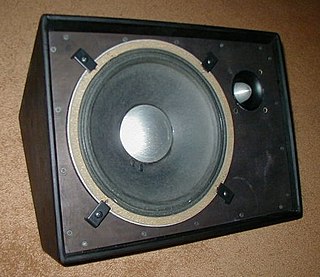
A stage monitor system is a set of performer-facing loudspeakers called monitor speakers, stage monitors, floor monitors, wedges, or foldbacks on stage during live music performances in which a sound reinforcement system is used to amplify a performance for the audience. The monitor system allows musicians to hear themselves and fellow band members clearly.

This is a glossary of jazz and popular music terms that are likely to be encountered in printed popular music songbooks, fake books and vocal scores, big band scores, jazz, and rock concert reviews, and album liner notes. This glossary includes terms for musical instruments, playing or singing techniques, amplifiers, effects units, sound reinforcement equipment, and recording gear and techniques which are widely used in jazz and popular music. Most of the terms are in English, but in some cases, terms from other languages are encountered.

HH Electronics is a British amplifier manufacturer that was founded in 1968 by Mike Harrison, Malcolm Green and Graham Lowes in Harston near Cambridge, England, where its first solid state TPA and MA range of studio quality amplifiers were designed and manufactured. These amplifiers were used by many recording and broadcasting studios, including the BBC.
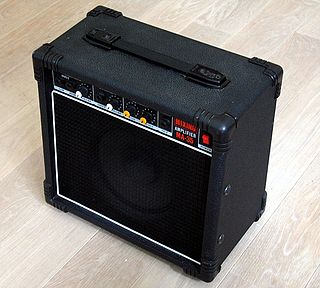
A keyboard amplifier is a powered electronic amplifier and loudspeaker in a wooden speaker cabinet used for the amplification of electronic keyboard instruments. Keyboard amplifiers are distinct from other types of amplification systems such as guitar amplifiers due to the particular challenges associated with making keyboards sound louder on stage; namely, to provide solid low-frequency sound reproduction for the deep basslines that keyboards can play and crisp high-frequency sound for the high-register notes. Another difference between keyboard amplifiers and guitar/bass amplifiers is that keyboard amps are usually designed with a relatively flat frequency response and low distortion. In contrast, many guitar and bass amp designers purposely make their amplifiers modify the frequency response, typically to "roll-off" very high frequencies, and most rock and blues guitar amps, and since the 1980s and 1990s, even many bass amps are designed to add distortion or overdrive to the instrument tone.
Clair Global, or simply Clair, is a professional sound reinforcement and live touring production support company. It was founded by brothers Roy and Gene Clair, who went into business in 1966 after they were asked to bring their sound system on tour with Frankie Valli and the Four Seasons. It is believed they were the first professional sound company to tour with a band. The company formally incorporated in 1970 as Clair Bros. Audio Enterprises, Inc.
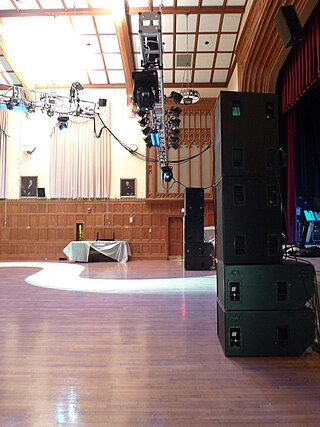
A professional audio store is a retail business that sells, and in many cases rents, sound reinforcement system equipment and PA system components used in music concerts, live shows, dance parties and speaking events. This equipment typically includes microphones, power amplifiers, electronic effects units, speaker enclosures, monitor speakers, subwoofers and audio consoles (mixers). Some professional audio stores also sell sound recording equipment, DJ equipment, lighting equipment used in nightclubs and concerts and video equipment used in events, such as video projectors and screens. Some professional audio stores rent "backline" equipment used in rock and pop shows, such as stage pianos and bass amplifiers. While professional audio stores typically focus on selling new merchandise, some stores also sell used equipment, which is often the equipment that the company has previously rented out for shows and events.
The Watkins Copicat is an audio effects unit that produces delay and reverb effects. One of the first commercially available tape delay units, the original Copicat model was produced by Watkins Electric Music beginning in 1958. The Copicat became one of Watkins' most successful products, and the company produced various Copicat models and versions over the following decades.
References
- ↑ "Watkins Electric Music History". Wemwatkins.co.uk. Retrieved 23 August 2020.
- 1 2 3 Peterson, David (January 2000). "The WEM Story". Guitar And Bass. Retrieved 31 January 2022.
- 1 2 3 4 5 Cooper, Gary (February 2015). "Charlie Watkins: Audio Pioneer 1923-2014". Sound On Sound. SOS Publications Group. Retrieved 21 February 2022.
- ↑ "WEM Shadow Echo". catalinbread.com. 26 March 2021. Retrieved 31 January 2022.
- ↑ Einarson, John. (2005). Mr. Tambourine Man: The Life and Legacy of the Byrds' Gene Clark. Backbeat Books. pp. 72–75. ISBN 0-87930-793-5.
- ↑ Menck, Ric. (2007). The Notorious Byrd Brothers (33⅓ series). Continuum Books. p. 44. ISBN 978-0-8264-1717-6.
- ↑ "Watkins Electric Music History". Wemwatkins.co.uk. Retrieved 23 August 2020.
- ↑ Duncan, Ben. "The History of PA (Part 1)". muzines.co.uk. Retrieved 6 September 2022.
- ↑ Coules, Andy (15 January 2015). "Modern Pioneers: The History Of PA, Part 2". prosoundweb. Retrieved 6 September 2022.
- ↑ Malkowski, Bob (28 August 2020). "7 Live Mixing Consoles That Changed the Industry Forever". gearnews.com. Retrieved 6 September 2022.
- ↑ Bennett, Ron (9 December 2011). "Charlie Watkins receives API Lifetime Achievement Award, London – UK". Accordions Worldwide. Retrieved 21 February 2022.
- ↑ Hunter, Dave (24 February 2022). "Here's How the Watkins Copicat Tape Delay Helped Define the Sound of an Era". GuitarPlayer.com. Future plc. Retrieved 6 September 2022.